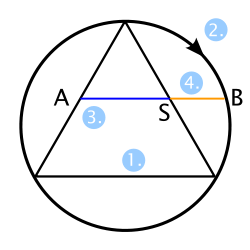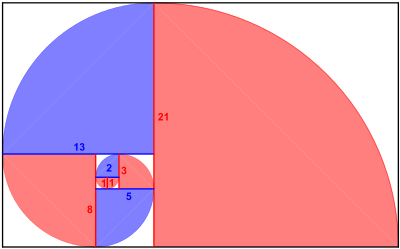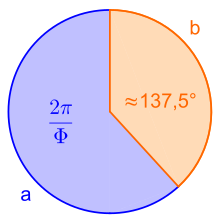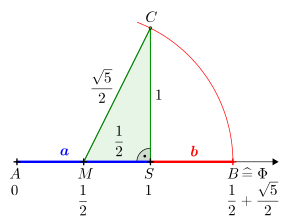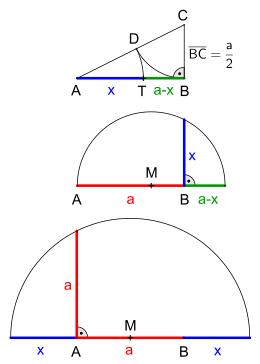Golden ratio
The golden ratio (Latin sectio aurea, proportio divina) is the division of a distance or other quantity in which the ratio of the whole to its larger part (also called the major) is equal to the ratio of the larger to the smaller part (the minor). Thus, with 


The division ratio of the golden section calculated as a number by dividing these quantities is an irrational number, i.e. a number that cannot be represented as a fraction of whole numbers. This number is also called the golden ratio or the golden number. The mathematical symbol for this number is usually the Greek letter Phi ( 





Knowledge of the golden section has been documented in mathematical literature since the time of Greek antiquity (Euclid of Alexandria). In the late Middle Ages (Campanus of Novara) and especially in the Renaissance (Luca Pacioli, Johannes Kepler), it was also placed in philosophical and theological contexts. Since the 19th century, it has been valued first in aesthetic theory (Adolf Zeising) and then also in artistic, architectural and craft practice as an ideal principle of aesthetic proportioning. However, there is no empirical evidence of a special aesthetic effect emanating from proportions of the golden ratio. Even the founder of empirical aesthetics, Gustav Theodor Fechner, stated on the basis of his own experiments: "Accordingly, I cannot but find the aesthetic value of the golden section ... overestimated." The historical question of whether the golden section already played a role in the proportioning of works of art and buildings of older epochs is also disputed.
The relationship of the golden section is not only important in mathematics, art or architecture, but is also found in nature, for example in the arrangement of leaves and in the inflorescences of some plants.
Geometric statements
Construction method
According to the postulates of Euclid, only those methods are accepted as construction methods that are limited to the use of compass and ruler (without scale). For the division of a line in the ratio of the golden section, there is an abundance of such methods, of which only a few are mentioned below as examples. A distinction is made between inner and outer division. In the case of the outer division, the point lying on the outside in the extension of the original line is sought, which makes the existing line a (larger) part of the golden section. The golden section is a special case of the harmonic division. Two modern constructions found by artists are also listed below.
Inner division
|
| Classic method with internal division, popular for its simplicity:
|
|
| Inner division according to Euclid:
Johann Friedrich Lorenz described in 1781 in his book Euclid's Elements the following task of Euclid: "To intersect a given straight line, AB, in such a way that the rectangle of the whole and one of the sections is equal to the square of the other section". The result of the animation opposite shows that the line As a representation of this process, a simplified construction, see left picture, has proven to be useful:
|
|
| Construction after the Austrian artist Kurt Hofstetter, which he published in Forum Geometricorum in 2005:
|
Outer division
|
| Classic procedure with external division:
This method is used, for example, for the construction of the pentagon with a given side length. |
|
| Construction after the American artist George Odom, who discovered it in 1982:
|
Instead of always having to construct anew, a Golden Compass - a reduction compass set to the Golden Ratio - was used by artists and craftsmen in the 19th century. In the carpentry trade in particular, a similar instrument in the form of a stork's beak was used.
The Golden Section in the Pentagon and the Pentagram
The regular pentagon and the pentagram each form a basic figure in which the relationship of the golden ratio occurs repeatedly. The side of a regular pentagon, for example, is in the golden ratio to its diagonals. The diagonals among themselves in turn also divide in the golden ratio, i.e., 



The pentagram, one of the oldest magical symbols in cultural history, has a particularly close relationship to the golden section. There is a partner for every line and part of a line in the pentagram that is related to it in the relationship of the golden section. In the illustration, all three possible pairs of routes are marked in blue (longer route) and orange (shorter route). They can be created one after the other using the continuous division method described above. In principle, this can be continued into the reduced pentagram, which could be drawn into the inner pentagon, and thus into all the others. If the two distances were in a ratio of whole numbers, this procedure of continued subtraction would have to result in zero at some point and thus break off. The observation of the pentagram, however, clearly shows that this is not the case. A further development of this geometry is found in the Penrose parquetry.
For the proof that it is the golden section, note that in addition to the many lines that are of equal length for obvious reasons of symmetry, 


If 
Golden Rectangle and Golden Triangle
A rectangle whose aspect ratio corresponds to the golden section is called a golden rectangle, and likewise an isosceles triangle in which two sides are in this ratio is called a golden triangle.
- For comparison of rectangular proportions, see section Comparison with other prominent aspect ratios.
- A golden triangle is the content of the method inner division in the section Construction method.
Golden corner
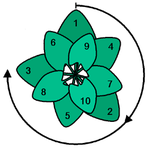
The golden angle is obtained when the solid angle is divided in the golden section. This leads to the obtuse angle 


By repeated rotation around the golden angle, new positions are created again and again, for example for the leaf beginnings in the picture. As with any irrational number, exact overlaps will never occur. Because the golden number is the most "irrational" number in the sense described below, the overlap of the leaves, which impedes photosynthesis, is minimised in total.
The first 





If we look at the decreasing divisions of the circle for increasing 





If we 


Golden spiral
The golden spiral is a special case of the logarithmic spiral. This spiral can be constructed by recursively dividing a golden rectangle into a square and another, smaller golden rectangle (see picture opposite). It is often approximated by a sequence of quarter circles. Its radius changes by a factor 
It applies
with the slope 




Consequently, the following applies to the slope:
The golden spiral is distinguished among the logarithmic spirals by the following property. Let 


Golden section in the icosahedron
The twelve corners of the icosahedron form the corners of three rectangles of the same size standing vertically on top of each other with a common centre and with the aspect ratios of the golden section. This arrangement of the three rectangles is also called the golden section chair. Because the icosahedron is dual to the pentagon dodecahedron, the twelve centres of the pentagons also form the corners of a golden section chair.
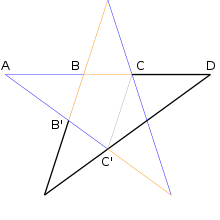
Pentagram
Golden spiral approximated by quarter circles. The ratio of the radii of the circle sectors corresponds to the Fibonacci sequence

Three Golden Rectangles in the Icosahedron
Mathematical properties
Derivation of the numerical value
Algebraic
The definition given in the introduction
reads with the right side dissolved and after conversion
respectively with 
Multiplication by 
with the two solutions 

Since of these two values only the positive one can be considered for the golden number, it follows that
Geometric
The approach is the definition given in the introduction
with a major 
On a number line, first the numerical value 















With the help of the Pythagorean theorem
thus obtains the hypotenuse
Finally, an arc is required around 






The numerical value of 
Summarised it also results in
The Golden Sequence of Numbers
| Golden number sequence for a0 = 1 | ||
| | | |
| 4 | ≈ 6,854 | |
| 3 | ≈ 4,236 | |
| 2 | ≈ 2,618 | |
| 1 | ≈ 1,618 | |
| 0 | = 1,000 | |
| −1 | ≈ 0,618 | |
| −2 | ≈ 0,382 | |
| −3 | ≈ 0,236 | |
| −4 | ≈ 0,146 | |
For a given number 





This sequence plays an important role in the theory of proportions in art and architecture, because for a given length 
It is worth mentioning that for 



Connection with the Fibonacci numbers
| Ratios of successiveFibonacci numbers | |||
| | | | Deviation to |
| 01 | 01 | = 1,0000 | −38,0000 |
| 01 | 02 | = 2,0000 | +23,0000 |
| 02 | 03 | = 1,5000 | −7,300 |
| 03 | 05 | ≈ 1,6667 | +3,000 |
| 05 | 08 | = 1,6000 | −1,100 |
| 08 | 13 | = 1,6250 | +0,430 |
| 13 | 21 | ≈ 1,6154 | −0,160 |
| 21 | 34 | ≈ 1,6190 | +0,063 |
| 34 | 55 | ≈ 1,6176 | −0,024 |
| 55 | 89 | ≈ 1,6182 | 0+0,0091 |
| 89 | 144 | ≈ 1,6180 | 0−0,0035 |
| 144 | 233 | ≈ 1,6181 | 0+0,0013 |
Closely related to the golden section is the infinite sequence of Fibonacci numbers (see below the sections on the Middle Ages and the Renaissance):
1, 1, 2, 3, 5, 8, 13, 21, 34, 55, 89, 144, 233 …
The next number in this sequence is obtained as the sum of the two preceding numbers. The ratio of two consecutive numbers in the Fibonacci sequence tends towards the golden ratio (see table). The recursive formation law 
Provided that this ratio 
This reasoning also applies to generalised Fibonacci sequences with any two initial members.
The members of the Fibonacci sequence 

where
This formula yields the correct initial values 




Approximation properties of the golden number
As indicated above, the golden number 




The golden number can be constructed directly from the requirement of the worst possible approximability by rational numbers. To understand this, consider the following procedure for approximating arbitrary numbers by a fraction using the example of the number π 





If this continued fraction evolution is terminated after finitely many steps, then for π 






If the continued fraction expansion of an irrational number 



In the continued fraction above, an integer appears before each plus sign. The larger this number, the smaller the fraction in whose denominator it appears, and therefore the smaller the error that occurs when the infinite continued fraction is terminated before this fraction. The largest number in the continued fraction section above is 

Reversing this argumentation, it now follows that the approximation is particularly bad if the number before the plus sign is particularly small. The smallest permissible number there is 
For the golden number, however, 
Since the continued fraction expansion of the golden number 
Another curious designation is the following: In the theory of dynamical systems, numbers whose infinite continued fraction representation contains only ones from any point on are called "noble numbers". Since the golden number has only ones in its continued fraction, it can (jokingly) be called the "noblest of all numbers".
From an algebraic-number-theoretical point of view
The golden section is an algebraic number as the zero of the polynomial 







is the golden section even unit of the integer ring 

However, the golden section is not only a unit of the holistic ring 













The whole boundary points of the convex hull of 



Other mathematical properties
- From following infinite chain root can be derived
:
- The square
and any higher integer power of
represented as the sum of an integer multiple of
and an integer multiple of 1. The fundamental significance of the golden section for quasiperiodic lattices is based on this property (see quasicrystal).
- More precisely,
(where
the
th Fibonacci number).
| A brief proof of this relationship is provided by the direct representation of the Fibonacci numbers using
the first assertion results after division by |
- From trigonometry follows, among other things
and



- The golden section can also be expressed with the help of the Eulerian number and the hyperbolic areasinus function:
- Substituting
into the geometric series formula ∑ k =


- Application of the binomial theorem to the relationship
gives:


Generalisation of the Golden Section
Geometric means
If the line 











![{\displaystyle {\bar {x}}_{\text{geom}}={\sqrt[{n}]{x_{1}\cdot x_{2}\dotsm x_{n}}}}](https://www.alegsaonline.com/image/8218f179881c3afe5663221e4b86c0c60bdd94b0.svg)
![{\displaystyle x={\sqrt[{2}]{a(a-x)}}}](https://www.alegsaonline.com/image/e155c4db85203c7f8d4366d8030b50851e8d6085.svg)


For any real 
For the ascending sequence: 
For the descending sequence: 
Continuous division
The geometric generalisation of the golden section by its multiple application is the continuous division of a line 








However, this general procedure can also be achieved by subtracting the line 



This sequence of steps is called a continuous division of a line
Analytically, the continuous division as a generalisation of the golden section is an example of self-similarity: If the resulting lengths of the lines are interpreted as real numbers, the following applies: If the shorter of the two lines is subtracted from the longer one, an even shorter line 

This statement is again analytically identical to the descending geometric sequence of the previous section. Consequently, the same statement applies to the extension of a given distance, it leads to the ascending geometric sequence.
From this statement, however, the following also applies: A rectangle with the sides 



Occurrence in nature
Biology
The most spectacular example of ratios of the golden section in nature is found in the arrangement of leaves (phyllotaxy) and in inflorescences of some plants. In these plants, the angle between two successive leaves divides the full circle of 360° in the ratio of the golden section when the two leaf bases are brought into alignment by a parallel displacement of one of the leaves along the plant axis. This is the golden angle of about 137.5°.
The resulting structures are also called self-similar: In this way, a pattern of a lower structural level is found in higher levels. Examples are the sunflower, cabbages, pine needles on young branches, cones, agaves, many palm and yucca species, and the petals of the rose, to name but a few.
The cause is the effort of these plants to keep their leaves at a distance. It is assumed that they produce a special growth inhibitor (inhibitor) at each leaf attachment for this purpose, which diffuses in the plant stem - mainly upwards, but to a lesser extent also in a lateral direction. In the process, certain concentration gradients form in different directions. The next leaf develops at a point on the circumference where the concentration is minimal. In the process, a certain angle to the predecessor is established. If this angle were to divide the full circle in the ratio of a rational number 

The benefit for the plant could be that sunlight (or water and air) falling from above is used optimally in this way, a conjecture already expressed by Leonardo da Vinci, or also in the more efficient transport of the carbohydrates produced by photosynthesis downwards in the phloem part of the vascular bundles. The roots of plants show the golden angle less clearly. In other plants, on the other hand, leaf spirals appear with other angles. For example, in some species of cacti an angle of 99.5° is observed, which corresponds to the variant of the Fibonacci sequence 1, 3, 4, 7, 11, .... In computer simulations of plant growth, these different behaviours can be provoked by appropriate choice of diffusion coefficients of the inhibitor.
In many plants organised according to the golden section, so-called Fibonacci spirals form in this context. Spirals of this type are particularly easy to recognise when the leaf spacing is particularly small compared to the circumference of the plant axis. They are not formed by successive leaves, but by those at a distance 



where is 




Fibonacci spirals (which are in turn associated with the golden section) are particularly impressive in inflorescences, as in sunflowers. There, flowers that later develop into fruits sit close together on the strongly compressed, disc-shaped inflorescence axis, whereby each individual flower can be assigned to its own circle around the centre of the inflorescence. Consecutive fruits in terms of growth are therefore spatially far apart, while direct neighbours again have a distance corresponding to a Fibonacci number. In the outer area of sunflowers, 34 and 55 spirals are counted, in larger specimens 55 and 89 or even 89 and 144. The deviation from the mathematical golden angle, which is not exceeded in this case, is less than 0.01 %.
The golden ratio can also be seen in radially symmetrical five-petalled flowers such as the bellflower, columbine and (wild) hedge rose. The distance between the tips of petals of nearest neighbours and those of the next but one is in proportion, as is usual with the regular pentagon. This also applies to starfish and other animals with pentagonal symmetry.
In addition, the golden section is also assumed in the ratio of the lengths of successive stem sections of some plants, as in the case of the poplar. In the ivy leaf, too, the leaf axes a and b (see illustration) are approximately in the ratio of the golden section. However, these examples are disputed.
Even in the 19th century, the view was widespread that the Golden Section was a divine law of nature and was also realised in many ways in the proportions of the human body. Adolf Zeising, for example, in his book on the proportions of the human body, assumed that the navel divided the height of the body in the ratio of the golden section, and the lower section was in turn divided in this way by the knee. Furthermore, the ratios of adjacent parts of the limbs, such as the upper and lower arm and the phalanges, seem to be approximately in this proportion. However, a close examination reveals scattering of the ratios in the 20 % range. Often the definition of how the length of a body part is to be exactly determined contains a certain amount of arbitrariness. Furthermore, this thesis still lacks a scientific basis. Therefore, the view largely dominates that these observations are merely the result of targeted selection of neighbouring pairs from a set of arbitrary sizes.
Railway resonances
It has long been known that the orbital periods of some planets and moons are in ratios of small integers, such as Jupiter and Saturn with 2:5 or the Jupiter moons Io, Ganymede and Europa with 1:2:4. Such orbital resonances stabilise the orbits of the celestial bodies in the long term against minor perturbations. It was not until 1964 that it was discovered that sufficiently irrational ratios, as would exist in the case 
Black holes
Contractible cosmic objects without a solid surface, such as black holes or the sun, have the paradoxical property of becoming hotter when they radiate heat (negative heat capacity) due to their self-gravity. In the case of rotating black holes, a switch from negative to positive heat capacity takes place above a critical angular momentum, whereby this tipping point depends on the mass of the black hole. In a 


result.
Crystal structures
The golden ratio also appears in the quasicrystals of solid-state physics, which were discovered by Dan Shechtman and his colleagues in 1984. These are structures with five-fold symmetry, from which, however, as Kepler already recognised, no strictly periodic crystal lattices can be built, as is usual for crystals. The surprise was correspondingly great when diffraction images with pentagonal symmetry were found in X-ray structural analyses. These quasicrystals structurally consist of two different rhombohedral basic building blocks with which the space can be filled without gaps but without global periodicity (Penrose parquetry). Both rhombohedra are composed of the same rhombic side faces, which are, however, oriented differently. The shape of these rhombuses can now be defined by the fact that their diagonals are in the ratio of the golden section. Shechtman was awarded the Nobel Prize in Chemistry in 2011 for the discovery of quasicrystals.

Golden section in the ivy leaf

Sunflower with 34 and 55 Fibonacci spirals
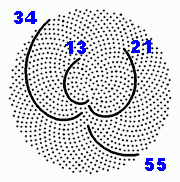
Calculated inflorescence with 1000 fruits in the Golden Angle - 13, 21, 34 and 55 Fibonacci spirals appear.
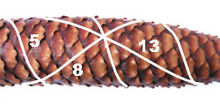
Spruce cones with 5, 8 and 13 Fibonacci spirals
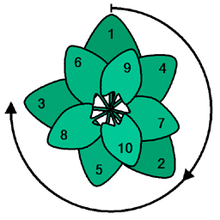
Arrangement of leaves at the distance of the golden angle viewed from above. The sunlight is used optimally.
See also
- Decagon
- Pentagon
- Zwanzigeck
- Square
- Silver cut
- List of special numbers
Questions and Answers
Q: What is the ratio of two numbers?
A: The ratio of two numbers is found by dividing them, so the ratio would be a/b.
Q: How can another ratio be found?
A: Another ratio can be found by adding the two numbers together and then dividing this sum by the larger number, a. This new ratio would be (a+b)/a.
Q: What is the name for when these two ratios are equal to each other?
A: When these two ratios are equal to each other, it is called the golden ratio. It is usually represented with Greek letter φ or phi.
Q: If b = 1 and a/b = φ , what does that mean for a?
A: If b = 1 and a/b = φ , then that means that a = φ as well.
Q: How can one way write this number?
A: One way to write this number is φ = 1 + 5 / 2 = 1.618...
Q: What does it mean if you subtract 1 from it or divide 1 by it?
A: If you subtract 1 from it or divide 1 by it, you will get back the same number - in other words, they will both equal the golden ratio.
Q: Is the golden ration an irrational number?
A: Yes, the golden ration is an irrational number which means that if someone tries to write it out, there will never be an end and no pattern - only starting with something like "1.6180339887..."
Search within the encyclopedia


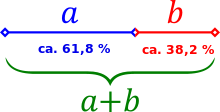

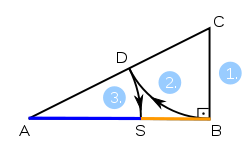
.svg.png)
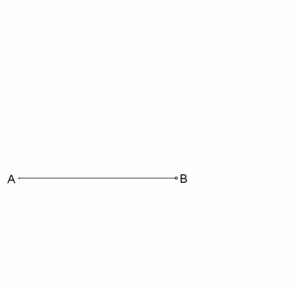
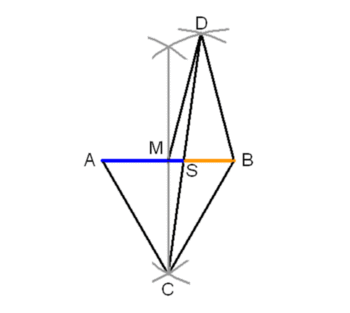
.svg.png)
